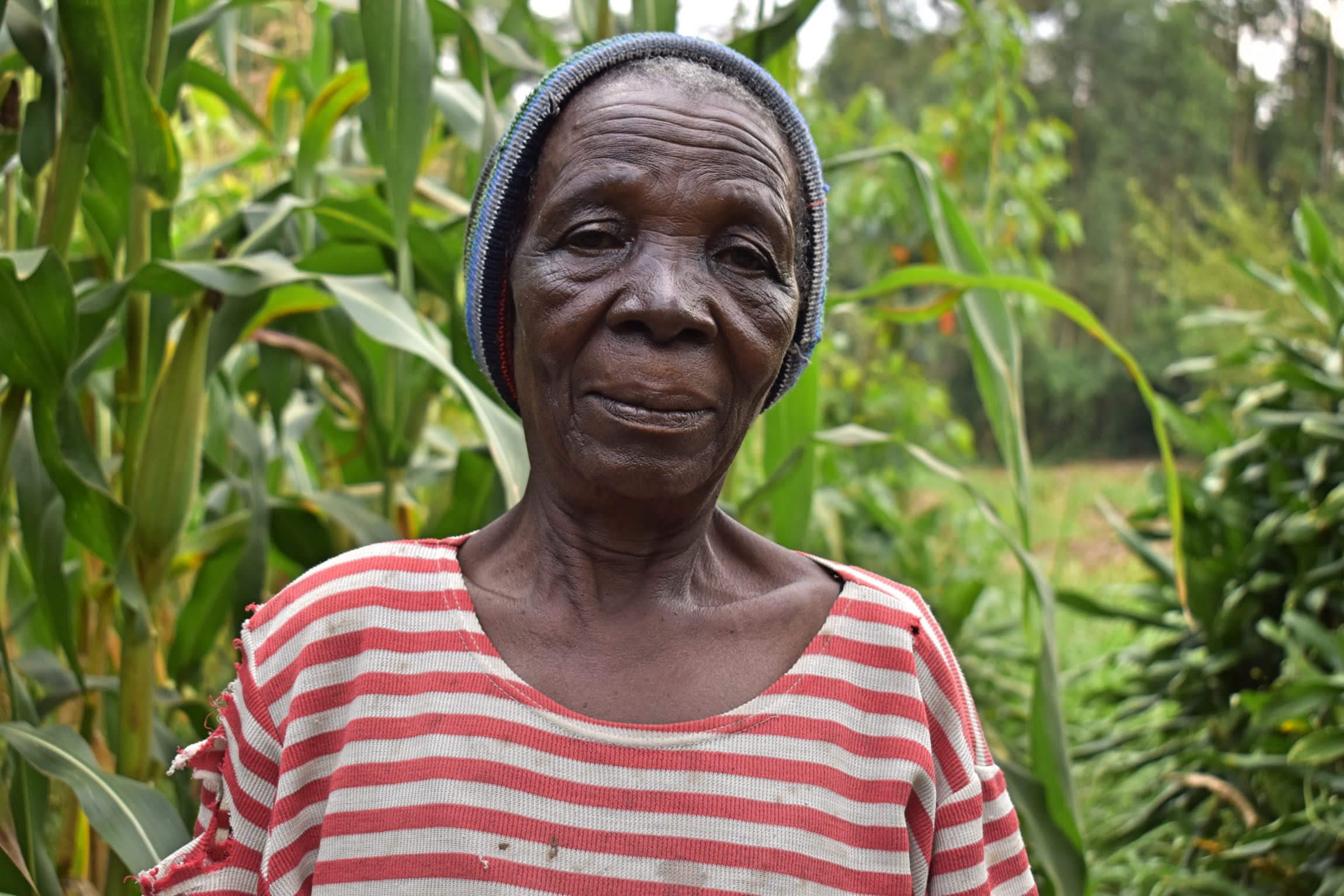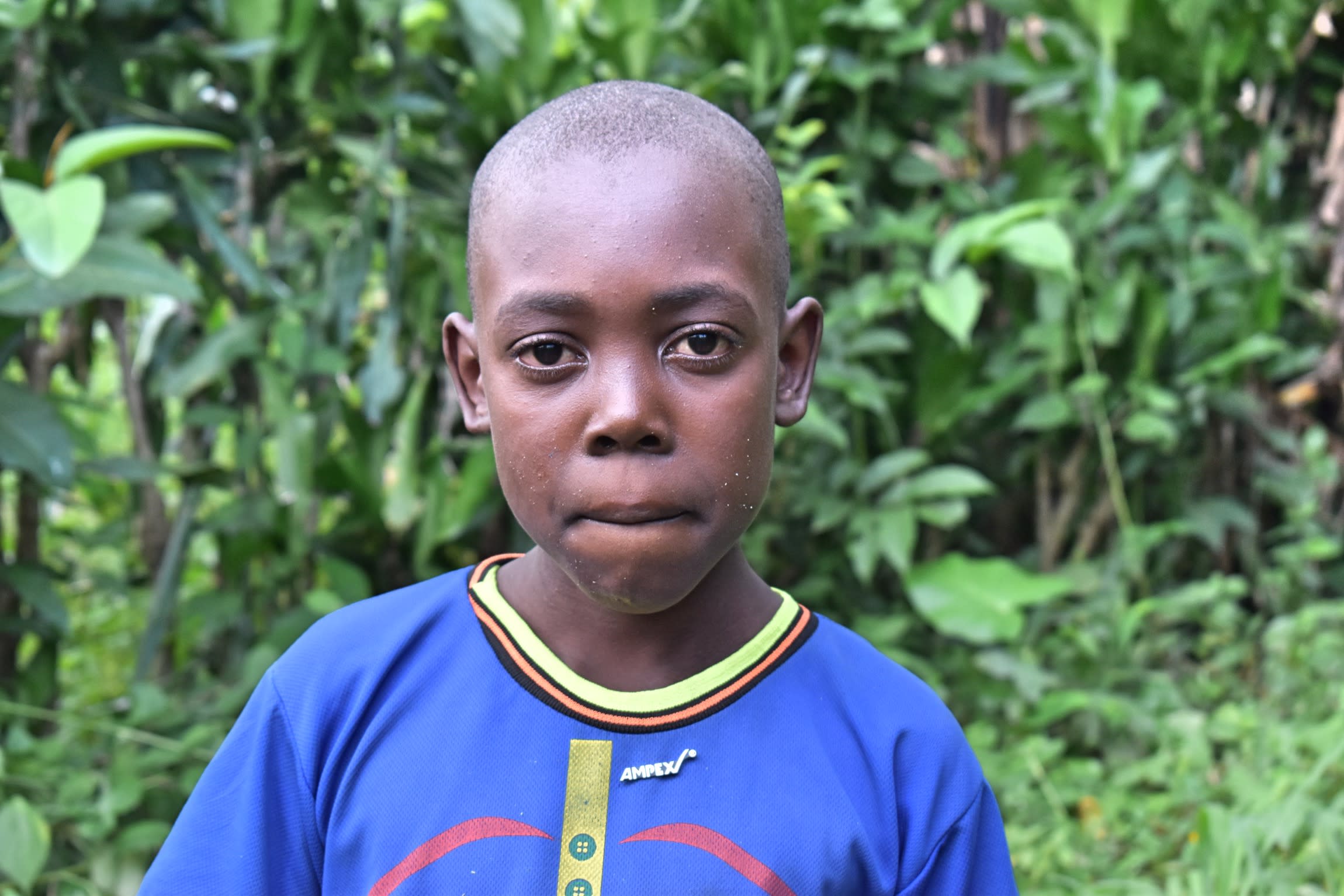February, 2023: Shilalunga Community Spring Protection Complete!
Shilalunga Community now has access to clean water! We transformed Oremo Spring into a flowing source of naturally filtered water thanks to your donation. Our team also trained the community on improved sanitation and hygiene practices. Together, these components will unlock the opportunity for community members to live better, healthier lives.
"Typhoid and other water-related illnesses got from consuming the open water will now be a thing of the past. We hope to put the money we were using for treatment into other productive areas," said 70-year-old farmer Teresia Oremo. "Quick access to water will improve our family's hygiene standards besides saving time used to fetch water. The time will be put into productive activities like farming and my business at the local market."

Teresia having a drink of water.
Children were just as excited as adults about the new waterpoint.
"With this new water point, fetching water will be easier and faster. No more wasting time on fetching water. We will also not miss school taking care of our sick parents because of consuming contaminated water," said 12-year-old Eugene M. "In the long run, this will positively impact my academic performance and my general growth and development."

Eugene at the spring.
Preparing for Spring Protection
Community members worked together to source and carry all locally available construction materials to the spring. These included bricks, sand, stones, and fencing poles. Some people also chiseled away at large rocks to break them down into gravel. Because people have to carry most items by hand, the material-collection process can take anywhere from a few weeks to months.
When the community was ready, we sent a lorry to deliver the remaining construction materials, including cement, plastic tarps, and hardware. Then, our construction artisan and field officers deployed to the spring to begin work. Individual households provided meals throughout each day to sustain the work team.
From Open Source to Protected Spring: A Step-by-Step Process
First, we cleared and excavated the spring area. Next, we dug a drainage channel below the spring and several runoff diversion channels above and around the spring. These help to divert surface contaminants away.
To ensure community members could still access water throughout the construction process, we also dug temporary channels from the spring's eye around the construction site. This allowed water to flow without disrupting community members' tasks or the construction work. Excavation created space for setting the spring's foundation, made of thick plastic tarp, wire mesh, concrete, and waterproof cement.

After establishing the base, we started brickwork to build the headwall, wing walls, and stairs. Once the walls had grown tall enough, we began one of the most crucial steps: setting the discharge pipe. The discharge pipe needs to be positioned low enough in the headwall so the water level never rises above the spring's eye, yet high enough to allow room for the average jerrycan (a 20-liter container) to sit beneath the pipe without making contact.
If we place the discharge pipe too high above the spring's eye, backpressure could force water to emerge elsewhere. Too low, and community members would not be able to access the water easily. We embedded the pipe using clay (or mortar when clay is in short supply) and placed it at an incline to ensure water flows in the right direction.

In coordination with brickwork, we pitched stones on both sides of the spring's drainage channel. We then cemented and plastered each stone, forming the rub walls. These walls discourage people and animals from standing in that area, which could cause soil erosion and a clogged drainage area.
We then cemented and plastered both sides of the headwall and wing walls. These finishing layers reinforce the brickwork and prevent water in the reservoir from seeping through the walls. In turn, enough pressure builds in the reservoir box to push water out through the discharge pipe.

As the headwall and wing walls cured, we cemented and plastered the stairs and installed four tiles beneath the discharge pipe. The tiles protect the concrete from the falling water's erosive force while beautifying the spring and facilitating easy cleaning of the spring floor.
The final stage of construction is backfilling the reservoir box behind the discharge pipe. We cleared the collection box of any debris that may have fallen during construction. Then we redirected the temporary diversion channels back into the reservoir box, channeling water into this area for the first time. We closed off all of the other exits to start forcing water through the discharge pipe only.

We filled up the reservoir area with the large, clean stones community members had gathered, arranging them in layers like a well-fitting puzzle. We covered the rocks with a thick plastic tarp to minimize potential contamination sources, then piled enough dirt on top to compensate for future settling.

Community members transplanted grass onto the backfilled soil to help prevent erosion. Finally, the collection area was fenced to discourage any person or animal from walking on it. Compaction can lead to disturbances in the backfill layers and potentially compromise water quality.
The entire construction process took about two weeks of work and patience to allow the cement and plaster to finish curing. As soon as the spring was ready, people got the okay from their local field officers to fetch water.

We officially handed over the spring to mark the community's ownership of the water point. Happiness, thanksgiving, and appreciation were the order of the day, flowing in all directions.
"In a small celebration headlined by the village elder, the community members sang in joy as they ululated at the water point. The new waterpoint was dedicated in prayer by the local pastor. After a short address by the village elder and the field officer, the attendants retreated for late lunch at one of the water users' homesteads," said field officer Elvia Afuya.
Training on Health, Hygiene, and More
Together with the community, we found their preferred date for training while considering other community calendar events, such as the agricultural season and social events. We requested a representative group of community members to attend training and relay the information learned to the rest of their family and friends.
When the day arrived, facilitators Amos and Elvis deployed to the site to lead the event. 16 people attended the training, including six women and ten men. We held the training at the homestead of a community member.

We covered several topics, including community participation in the project, leadership and governance, personal and environmental hygiene, water handling and treatment, spring maintenance, dental hygiene, the ten steps of handwashing, disease prevention, and how to make and use handwashing stations.
During the leadership and governance session, we held an election for the newly formed water user committee leaders, who will oversee the maintenance of the spring. We also brainstormed income-generating activities. Community members can now start a group savings account for any future minor repairs to the spring and a cooperative lending group, enabling them to develop small businesses.

Trainer Elvis Afuya said, "Participants were surprisingly frank with their body hygiene practices. They willfully shared both good and bad practices they carry out at personal levels. This topic provided adequate fodder for discussion with an aim of learning and unlearning. While some practices came out as funny, the participants got a chance to learn how to correct whatever wasn’t [being] done correctly."

Oral hygiene session.
Our session on dental hygiene was popular.
"Participants confessed to using chew sticks to brush their teeth," Amos said. "After the discussion, they were more than willing to acquire toothbrushes and toothpaste to use for brushing. One of them noted that if they continued using sticks, they might exhaust trees in the near future, making participants burst into hearty laughter. The participants were also amazed to learn through the demonstration that they ought to brush their tongues, something most of the participants have not done since birth."

Eugene.
"I have learned a number of things that I believe will be instrumental to my hygiene and sanitation. With the toothbrush I have received, I will start brushing my teeth tomorrow, deploying the technique that I have learned today. I’m confident my dental hygiene will never be the same again," said 12-year-old Eugene M. (quoted earlier).
Conclusion
This project required a substantial collaboration between our staff, our in-country teams, and the community members themselves. When an issue arises concerning the spring, the water user committee is equipped with the necessary skills to rectify the problem and ensure the water point works appropriately. However, if the issue is beyond their capabilities, they can contact their local field officers to assist them.
Also, we will continue to offer them unmatchable support as a part of our monitoring and maintenance program. We walk with each community, problem-solving together when they face challenges with functionality, seasonality, or water quality. Together, all these components help us strive for enduring access to reliable, clean, and safe water for this community.
With your contribution, one more piece has been added to a large puzzle of water projects. In our target areas, we’re working toward complete coverage of reliable, maintained water sources within a 30-minute round trip for each community, household, school, and health center. With this in mind, search through our upcoming projects to see which community you can help next!
Thank you for making all of this possible!




 Protected Spring
Protected Spring
 Rehabilitation Project
Rehabilitation Project



































